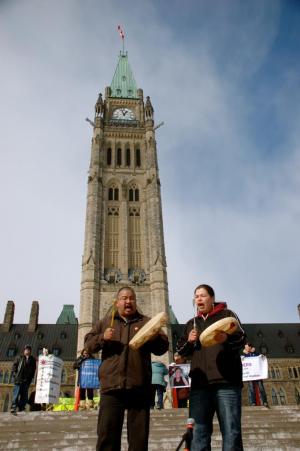Secondary menu
Human Rights: A Framework to Respond to Violence Against Aboriginal Women and Girls
Lara Koerner Yeo, 1L
 Lara was a research assistant in the Women’s Rights Division of Human Rights Watch and currently works with the Canadian Feminist Alliance for International Action.
Lara was a research assistant in the Women’s Rights Division of Human Rights Watch and currently works with the Canadian Feminist Alliance for International Action.
In Canada, Aboriginal women and girls are more likely to be murdered than any other female demographic, and the rate of their disappearance is overrepresented among missing women. State failure to respond to such disproportionate violence against Aboriginal women and girls has led to one of the most egregious human rights crises in Canada’s modern time.
Canada has ratified core international human rights treaties, including the International Covenant on Civil and Political Rights and the Convention on the Elimination of All Forms of Discrimination, which oblige states to meet comprehensive human rights standards. By ratifying these treaties, Canada is positively obliged to exercise due diligence in preventing, investigating, prosecuting, and punishing acts of violence perpetrated by non-state actors against anyone who lives in Canada, including Aboriginal women and girls.
Women’s and human rights organizations in Canada have championed the human rights framework in calling for improved state and police response to violence against Aboriginal women and girls. The Canadian Feminist Alliance for International Action (FAFIA) and Native Women’s Association of Canada have advocated at the UN for over ten years on the issue. In 2012 and 2013, these organizations also initiated and participated in hearings on the issue at the Inter-American Commission on Human Rights (IACHR).
Shelagh Day, the Human Rights Committee chair of FAFIA, has been engaged in FAFIA’s advocacy at the UN and IACHR. When questioned about the importance of human rights law in domestic advocacy, Day highlights how human rights law inherently centers on state responsibility and thus provides an important tool for domestic advocates to hold a state accountable.
Day notes that human rights law has been agreed to by the international community and has clearer, more comprehensive protections than domestic law in regards to the state’s responsibility to address violence against women. Human rights law provides women’s rights advocates with a universal language, which can be used in myriad domestic contexts to understand and articulate what it means to protect women from violence and to press for improved state response.
Canada’s persistent failure to prevent and respond to continued violence against Aboriginal women and girls has led to investigations by the IACHR and UN Committee on the Elimination of Discrimination against Women (CEDAW Committee), which is indicative of the seriousness of this crisis.
The groundbreaking IACHR report, Missing and Murdered Indigenous Women in British Columbia, Canada, released on January 12, 2015, asserts that this violence is rooted in a history of gross discrimination and systemic social and economic marginalization of Aboriginal peoples in Canada.
The report affirms Canada’s legal obligation to improve its response to the violence, including through addressing social and economic risk factors that make Aboriginal women and girls disproportionately vulnerable to violence. The IACHR report, and the forthcoming CEDAW Committee report, focus public attention on systemic violations of rights that UN treaty bodies have commented on for years.
However, violence against Aboriginal women has not yet been embraced by the government as a crisis that requires a rights-based response. Too often the issue is framed as a number of isolated crimes and atomized failures of the criminal justice system, instead of as a systemic human rights crisis caused and perpetuated by chronic violations of women’s civil, political, economic, social, cultural, and indigenous rights.
Meghan Rhoad, researcher in the Women’s Rights Division of Human Rights Watch and author of “Those Who Take Us Away: Abusive Policing and Failures in Protection of Indigenous Women and Girls in Northern British Columbia, Canada”, considers the IACHR and CEDAW Committee reports to be important, in part, because of how they came about.
Rhoad credits the existence of the reports to the persistent, strategic work of domestic advocates, as well as to human rights reporting by domestic and international non-profit organizations. In conversation, Rhoad reflects on how she is often asked what individuals can do to take action on this issue and contribute in some positive way to alleviating the crisis. A starting point is the recognition of human rights as a framework for improved state response, she said.
While Canada’s current federal government has stymied any rethinking or refocusing on this issue, Canadians have a collective voice and can come together to demand change. In Day’s words, this is a time of contradiction. There is currently activity on social networks, in mainstream media, and on the streets. Examples include targeted Twitter activity under the #MMIW hashtag, and social media campaigns, such as #AmINext and #ImNotNext, gaining mainstream media attention. There are also annual days of action when Aboriginal women and allies take to the streets.
Aboriginal women and families have broken the silence about violence and have profoundly changed public understanding through these campaigns. They demand change and share their stories in an awe-inspiring and hope-inducing way.
Despite these efforts, there is no real institutional change, no government action to address the systemic and structural discrimination that is the root cause of the violence. It is a time of contradiction and conflict as Aboriginal women, supported by allies, continue to seek respect for, and fulfillment of, their human rights.
Photo: Vigil in Ottawa for Murdered and Missing Aboriginal Women, March 5, 2014 (Credit: Loretta Saunders, Creative Commons)
